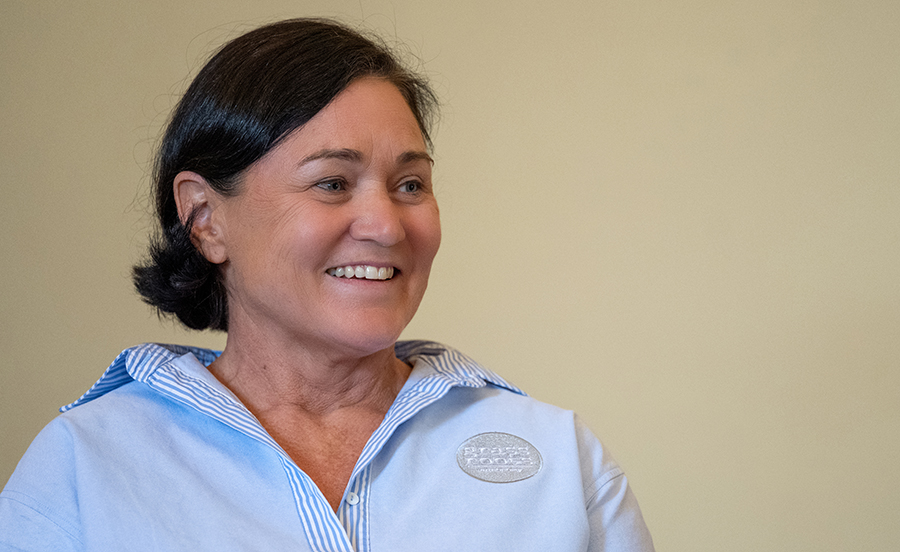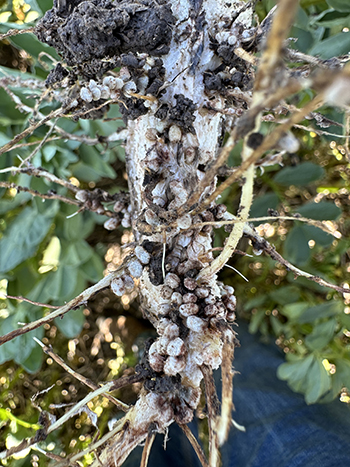An agronomy consultant says a single application of a new-chemistry fungicide has proven sufficient to protect faba beans against disease in the low-to-medium-rainfall areas of southern New South Wales.
Grassroots Agronomy consultant Kirrily Condon told growers and agronomists at a GRDC–Brill Ag faba bean workshop in March at Ganmain, NSW, that in the past two years their clients in low-to-medium rainfall areas had only applied one fungicide spray to faba beans each year.

Grassroots Agronomy consultant Kirrily Condon encourages clients to apply a new-chemistry fungicide before faba bean canopy closure. Photo: Nicole Baxter
“In 2022 and 2023, we moved away from those early fungicide sprays and applied a new-chemistry fungicide at pre-canopy closure,” she says.
“In high-rainfall areas, where the growing season is longer, we advised clients to apply two fungicide sprays.”
High-rainfall strategy
In high-rainfall areas, she said pydiflumetofen + fludioxonil (Miravis® Star) was applied before canopy closure and topped up with azoxystrobin + cyproconazole (Amistar® Xtra) at the end of the season.
“Those crops can yield over six tonnes per hectare, so the cost is justified,” she said. “If conditions turn dry, perhaps we don’t need to apply fungicide, but I’m a little conservative. If it is a dry spring, I would budget for pydiflumetofen + fludioxonil (Miravis® Star) and apply the lower end of the label rates.”
For the past 20 years, Grassroots Agronomy has worked with Ganmain grower Ben Cruikshank to grow faba beans, and she said they had learned a lot together.
“We didn’t get it right a long time ago,” she said. “But we now have confidence in our fungicide strategy, and disease doesn’t worry us anymore.”
She said their clients returned to PBA Samira because of its reliability.
“Season 2023 was the only year it burned us a little, with colder overnight temperatures followed by really hot daytime temperatures, and PBA Samira was mid-flowering,” she said.
“The crops had the potential to yield 4t/ha, but the conditions dropped yields back to 2t/ha.”
Accordingly, she said their clients wanted to grow shorter-season northern varieties such as PBA Nasma and FBA Ayla to spread the heat and frost risk.
Faba bean adaptation
 A faba bean planted on grey soil on Stephen Cooper’s farm near Caragabal, New South Wales. Notice how well the plant is nodulating. Photo: Grassroots Agronomy
A faba bean planted on grey soil on Stephen Cooper’s farm near Caragabal, New South Wales. Notice how well the plant is nodulating. Photo: Grassroots Agronomy
Ms Condon said faba beans could be grown anywhere that soil acidity was not a constraint, and they were relatively tolerant of waterlogging.
She said their clients targeted a pHCa of more than 5.5 at 0 to 5 centimetres, 5 to 10cm, 10 to 15cm and 15 to 20cm.
“Because faba beans produce so much biomass and nitrogen, our clients wanted to bring them on to their red soils, so we had to fix the soil pHCa and use 5cm segmented soil sampling through the profile to find the acid throttle.
“In 2021, when conditions were wet, soil acidity didn’t matter as much because the faba beans punched through the acid throttle, and we didn’t see much impact on grain yield.
“But in more-average autumns, if plant roots spend a prolonged period of time in acid soil with a pHCa of less than 5.0, faba beans can struggle.”
Accordingly, she said her focus had been on gathering 5cm segmented soil samples because 0 to 10cm soil samples were “pretty useless” for determining lime requirements because they masked the acid subsurface.
“You need to do those 5cm segmented tests to a depth of 20cm and apply lime rates accordingly. Often, you might need 3 to 4t/ha of lime, which is expensive, but you need to put on enough for each acid layer and mix it into the required depth.”
She said most clients had been liming for up to 20 years by applying 2.5 to 3t/ha of lime to the surface every six to eight years. However, 5cm soil tests still showed a pHCa of 6.0 to 6.5 in the 0 to 5cm layer and sometimes a pHCa of 4.0 to 4.5 in the 5 to 10cm layer.
“If your faba bean roots linger in that low pHCa, they’ll curl up their toes.
“It’s been a big commitment for our clients to spend time and money on lime incorporation, but it has allowed them to extend faba bean production to their red soils, and we have seen significant yield increases in the following canola crops and even the next cereal crop because of the nitrogen legacy.”
She said canola yield increases averaged about 0.5t/ha and up to 1t/ha, depending on the season.
Farming system benefits
Ms Condon said she calculated the gross margin of faba beans over four years to account for their benefits across the farming system.
“If you calculate a one-year gross margin on faba beans, you’ll be disappointed,” she said. “But over four years, they pay their way and improve the resilience of your farming system.”
More information: Kirrily Condon, kirrily@grassrootsag.com.au

























































